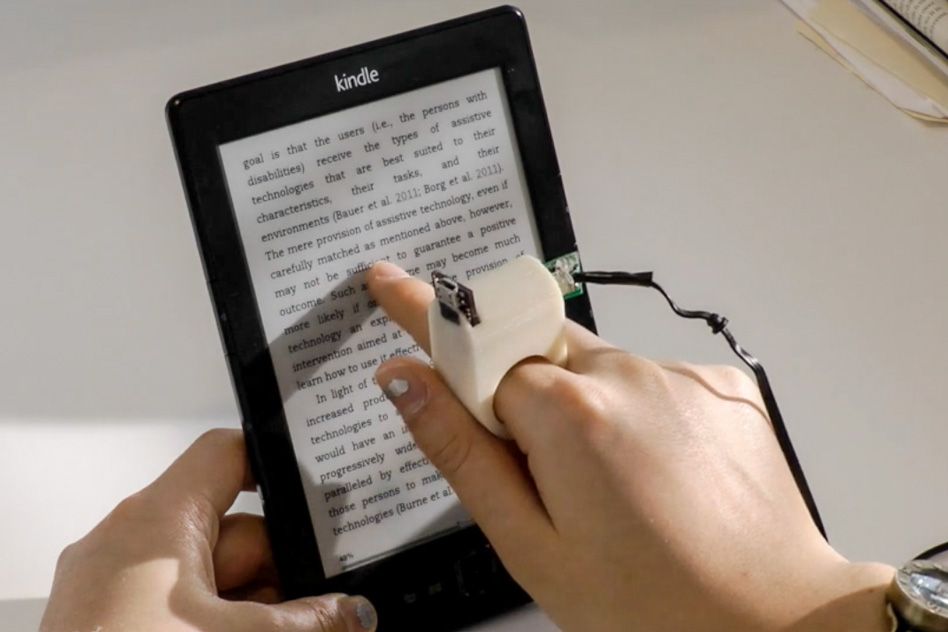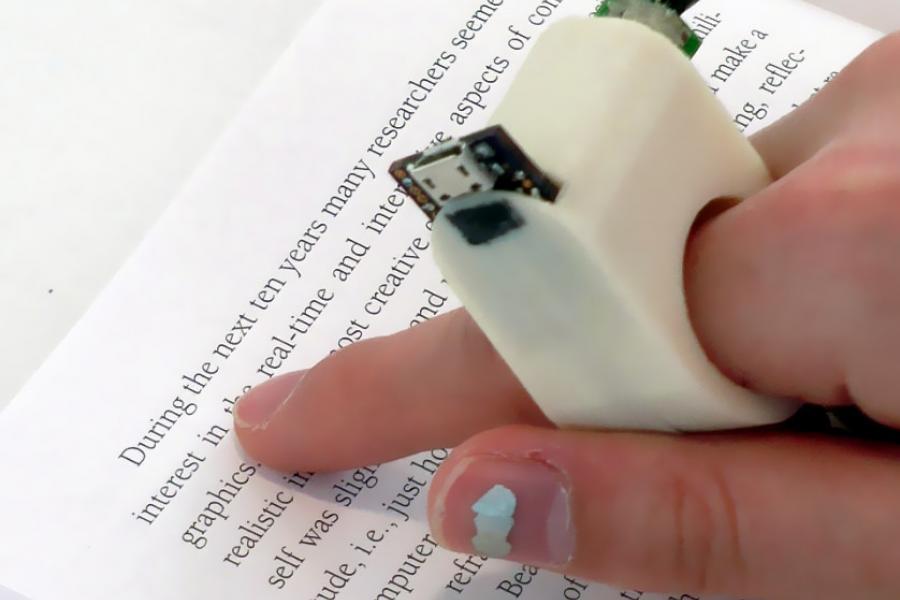Discover Innovative Tools Designed for the Aesthetically Impaired
The growth of cutting-edge tools for the aesthetically impaired stands for a significant innovation in availability and freedom. Technologies such as smart glasses with AI capacities and mobile applications developed to supply acoustic descriptions are improving daily experiences for customers. Additionally, wearable devices that utilize haptic feedback enhance environmental awareness, while modern Braille advancements use new means to engage with message. As these tools proceed to evolve, their influence on the lives of those with visual problems elevates crucial questions regarding the future of inclusivity and autonomy in different elements of life. What exists in advance in this technological landscape?
Smart Glasses for Navigating

Smart glasses created for navigation are changing the means aesthetically damaged people connect with their environment. These innovative gadgets make use of a mix of cam technology, artificial knowledge, and acoustic feedback to give real-time info concerning environments. By utilizing challenge discovery systems, wise glasses can notify individuals to prospective dangers, enabling more secure movement in both unknown and acquainted settings.
The combination of GPS technology even more improves navigating capacities, allowing individuals to receive acoustic instructions as they move. This hands-free strategy not only cultivates freedom but likewise equips aesthetically impaired individuals to navigate city landscapes with boosted confidence. In addition, numerous smart glasses are outfitted with attributes that identify spots and road indications, offering contextual details that boosts the individual experience.
Furthermore, the growth of these tools is constantly progressing, with business functioning to boost the accuracy of object recognition and increase the variety of navigational features. As wise glasses end up being a lot more budget-friendly and accessible, they hold the possible to dramatically change daily life for aesthetically damaged customers. Inevitably, these cutting-edge tools represent a vital action towards inclusivity, offering boosted mobility and a higher feeling of freedom for individuals navigating the world around them.

Mobile Application for Daily Living
Just how can mobile applications improve the lives of visually impaired individuals? Mobile apps are reinventing the means aesthetically damaged individuals browse their settings, take care of daily jobs, and gain access to information. These applications supply essential support through different performances, fostering independence and boosting lifestyle.
Numerous ingenious mobile applications are created specifically for everyday living. Applications like Be My Eyes connect aesthetically impaired users with sighted volunteers through video calls, allowing them to obtain real-time support with tasks such as reading labels or navigating unfamiliar spaces. In A Similar Way, Seeing AI, developed by Microsoft, makes use of man-made intelligence to define surroundings, checked out message, and determine objects, properly transforming a smartphone into an effective tool for everyday support.
Furthermore, navigating apps customized for the visually damaged, such as Aira and BlindSquare, provide audio-based instructions and environmental info, making it possible for individuals to traverse their environments safely and confidently. Past navigation and immediate assistance, mobile apps likewise support organization and task administration, with attributes that help customers establish suggestions, create to-do checklists, and track appointments. In recap, mobile applications work as vital resources, encouraging aesthetically damaged people to lead even more independent and fulfilling lives.
Wearable Technologies for Assistance
Empowerment with innovation is progressively noticeable in the world of wearable devices made to help visually impaired people. These cutting-edge devices integrate flawlessly right into day-to-day live, boosting navigating and supplying important feedback to users. For circumstances, smart glasses equipped with cameras can recognize faces and read message aloud, allowing customers to connect even more with confidence in social and specialist setups.
An additional significant development is making use of haptic comments systems in wearable gadgets. These systems make use of resonances or various other tactile signals to share info about the customer's atmosphere, such as challenges or modifications in surface, improving wheelchair and safety. Wearable modern technologies also include wristbands that connect to smart devices, signaling individuals to notifications with subtle vibrations, thus improving connectivity without dependence on aesthetic hints.
As these innovations remain to advance, they are not only boosting independence for visually damaged individuals however additionally promoting a better feeling of incorporation in culture. By bridging the space in between challenges faced in daily living and the potential for autonomy, wearable modern technologies work as critical tools in the pursuit for equality and empowerment for those with aesthetic disabilities.
Sound Summary Devices
Sound summary devices play a vital duty in enhancing accessibility for visually damaged people, supplying them with the capacity to involve with aesthetic media. Braille displays and notetakers. These devices provide narrated descriptions of vital aesthetic components in movies, tv shows, and live performances, making certain that users can fully comprehend the context and feelings conveyed via visuals
Sound summary can be integrated right into numerous platforms, including streaming services, movie theater screenings, and live movie theater. Many preferred streaming solutions currently consist of audio description as click site an availability attribute, allowing visitors to choose it quickly. In addition to traditional my blog media, specialized applications additionally exist, offering audio descriptions for art exhibits, galleries, and other social events.
The performance of audio summary depends upon the ability of the narrators, that need to share visual information succinctly without diminishing the initial sound. Innovations in this area are additionally paving the method for even more personalized experiences, where customers can change the level of detail and pacing according to their preferences.
Braille Innovations and Tools
Braille technologies and devices have actually dramatically transformed the means aesthetically damaged people connect with message and information. Modern innovations have actually led to the advancement of functional devices that enhance literacy and self-reliance amongst individuals. Significantly, Braille display technologies have actually developed, permitting vibrant analysis experiences. These gadgets transform electronic text right into Braille, making it possible for individuals to access a huge variety of info on tablets, computer systems, and mobile phones.
In addition, mobile Braille notetakers combine traditional Braille input with modern performances, helping with note-taking, organizing, and file modifying on the move. Smart glasses for the visually impaired. These small devices typically include text-to-speech capabilities, linking the space between Braille and auditory details
Furthermore, cutting-edge Braille printers have actually emerged, permitting great post to read individuals to create Braille labels, records, and instructional products successfully. This accessibility fosters greater participation in instructional and specialist atmospheres, ultimately promoting inclusivity.
In addition, research study right into wise Braille modern technologies remains to expand. Instruments that include expert system are being checked out to supply real-time navigating assistance and contextual info, boosting the individual experience in diverse setups. On the whole, these advancements reflect a commitment to encouraging visually impaired individuals with technology, guaranteeing they can quickly access and engage with the globe around them.

Verdict
The improvement of innovative devices for the visually damaged significantly enhances freedom and top quality of life. These innovations not just foster greater addition but likewise promote autonomy in everyday tasks, inevitably contributing to a more equitable and obtainable society for visually impaired individuals.
As smart glasses end up being much more budget-friendly and easily accessible, they hold the possible to dramatically change daily life for aesthetically impaired customers. Mobile applications are reinventing the way aesthetically impaired individuals navigate their settings, manage day-to-day tasks, and accessibility information. Apps like Be My Eyes link visually impaired users with sighted volunteers using video calls, enabling them to receive real-time help with tasks such as reading labels or browsing unknown areas.Furthermore, navigating applications customized for the visually impaired, such as Aira and BlindSquare, use audio-based instructions and environmental info, allowing individuals to traverse their environments securely and confidently.The improvement of ingenious devices for the visually damaged substantially improves independence and top quality of life.